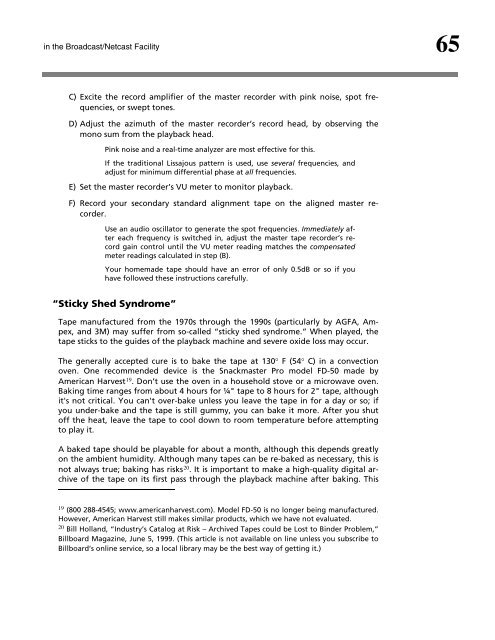Maintaining Audio Quality in the Broadcast Facility 2011 - Orban
Maintaining Audio Quality in the Broadcast Facility 2011 - Orban
Maintaining Audio Quality in the Broadcast Facility 2011 - Orban
You also want an ePaper? Increase the reach of your titles
YUMPU automatically turns print PDFs into web optimized ePapers that Google loves.
<strong>in</strong> <strong>the</strong> <strong>Broadcast</strong>/Netcast <strong>Facility</strong> 65<br />
C) Excite <strong>the</strong> record amplifier of <strong>the</strong> master recorder with p<strong>in</strong>k noise, spot frequencies,<br />
or swept tones.<br />
D) Adjust <strong>the</strong> azimuth of <strong>the</strong> master recorder’s record head, by observ<strong>in</strong>g <strong>the</strong><br />
mono sum from <strong>the</strong> playback head.<br />
P<strong>in</strong>k noise and a real-time analyzer are most effective for this.<br />
If <strong>the</strong> traditional Lissajous pattern is used, use several frequencies, and<br />
adjust for m<strong>in</strong>imum differential phase at all frequencies.<br />
E) Set <strong>the</strong> master recorder’s VU meter to monitor playback.<br />
F) Record your secondary standard alignment tape on <strong>the</strong> aligned master recorder.<br />
Use an audio oscillator to generate <strong>the</strong> spot frequencies. Immediately after<br />
each frequency is switched <strong>in</strong>, adjust <strong>the</strong> master tape recorder’s record<br />
ga<strong>in</strong> control until <strong>the</strong> VU meter read<strong>in</strong>g matches <strong>the</strong> compensated<br />
meter read<strong>in</strong>gs calculated <strong>in</strong> step (B).<br />
Your homemade tape should have an error of only 0.5dB or so if you<br />
have followed <strong>the</strong>se <strong>in</strong>structions carefully.<br />
“Sticky Shed Syndrome”<br />
Tape manufactured from <strong>the</strong> 1970s through <strong>the</strong> 1990s (particularly by AGFA, Ampex,<br />
and 3M) may suffer from so-called “sticky shed syndrome.” When played, <strong>the</strong><br />
tape sticks to <strong>the</strong> guides of <strong>the</strong> playback mach<strong>in</strong>e and severe oxide loss may occur.<br />
The generally accepted cure is to bake <strong>the</strong> tape at 130� F (54� C) <strong>in</strong> a convection<br />
oven. One recommended device is <strong>the</strong> Snackmaster Pro model FD-50 made by<br />
American Harvest 19 . Don’t use <strong>the</strong> oven <strong>in</strong> a household stove or a microwave oven.<br />
Bak<strong>in</strong>g time ranges from about 4 hours for ¼" tape to 8 hours for 2" tape, although<br />
it's not critical. You can't over-bake unless you leave <strong>the</strong> tape <strong>in</strong> for a day or so; if<br />
you under-bake and <strong>the</strong> tape is still gummy, you can bake it more. After you shut<br />
off <strong>the</strong> heat, leave <strong>the</strong> tape to cool down to room temperature before attempt<strong>in</strong>g<br />
to play it.<br />
A baked tape should be playable for about a month, although this depends greatly<br />
on <strong>the</strong> ambient humidity. Although many tapes can be re-baked as necessary, this is<br />
not always true; bak<strong>in</strong>g has risks 20 . It is important to make a high-quality digital archive<br />
of <strong>the</strong> tape on its first pass through <strong>the</strong> playback mach<strong>in</strong>e after bak<strong>in</strong>g. This<br />
19 (800 288-4545; www.americanharvest.com). Model FD-50 is no longer be<strong>in</strong>g manufactured.<br />
However, American Harvest still makes similar products, which we have not evaluated.<br />
20 Bill Holland, “Industry’s Catalog at Risk – Archived Tapes could be Lost to B<strong>in</strong>der Problem,”<br />
Billboard Magaz<strong>in</strong>e, June 5, 1999. (This article is not available on l<strong>in</strong>e unless you subscribe to<br />
Billboard’s onl<strong>in</strong>e service, so a local library may be <strong>the</strong> best way of gett<strong>in</strong>g it.)



![[PDF] Using the ITU BS.1770-2 and CBS Loudness Meters ... - Orban](https://img.yumpu.com/50629372/1/190x245/pdf-using-the-itu-bs1770-2-and-cbs-loudness-meters-orban.jpg?quality=85)






![[PDF] Optimod-FM Feature Comparison - Orban](https://img.yumpu.com/41741615/1/190x245/pdf-optimod-fm-feature-comparison-orban.jpg?quality=85)






